American Civil War
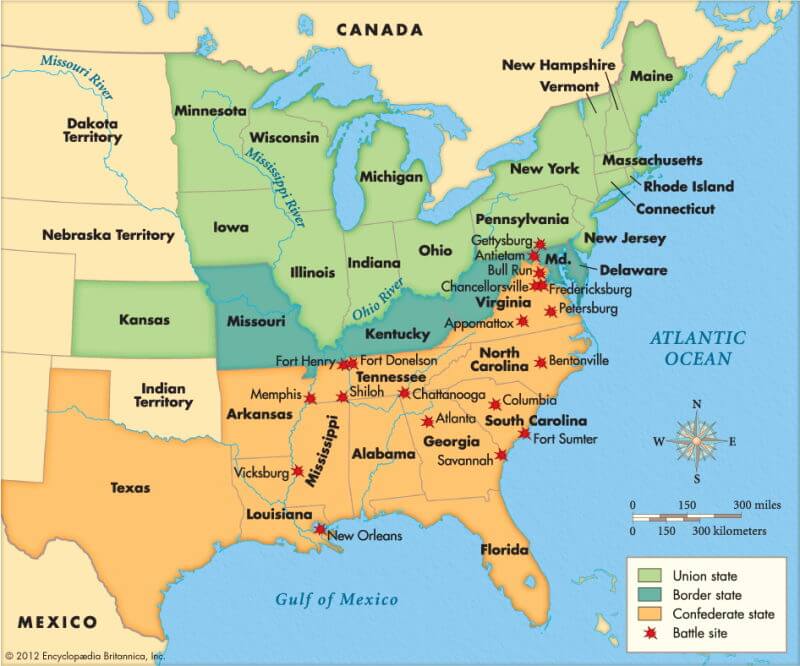
The American Civil War from 1861-1865 is the central event in America’s history after decades of tensions between the northern and southern states over slavery, states’ rights and westward expansion. Other names by the Northerners for this War are – “war to preserve the Union,” the “war of the rebellion” (war of the Southern rebellion), and the “war to make men free.”, while the Southerners may refer to it as the “war between the States” or the “war of Northern aggression”.
While the American Revolution of 1776-1783 strived to bring independence to the United States, the Civil War determined what kind of a nation it would be. The war was determined to resolve two main questions that the freedom revolution left unanswered – whether the United States should be a coalition (confederation) of sovereign states or a united nation with a sovereign national government; or whether this largest slaveholding country in the world, born of a declaration stating all men equal, would continue to exist as it it.
Victory in this war preserved the United States as one nation and ended the historic institution of slavery that had been prevalent in this country from its beginning. But this change came at the cost of 6,25,000 lives – nearly as many American soldiers as died in all other wars the country has ever fought, combined.
The main reason behind the Civil War was the uncompromising differences between the free and slave states. When Abraham Lincoln, the first Republican president, won election in 1860, he pledged to keep slavery out of the territories of the nation. Seven southern states-Confederate states of America (South Carolina, Mississippi, Florida, Alabama, Georgia, Louisiana and Texas) seceded from the nation to form the Confederate States of America, soon four more states joined them.
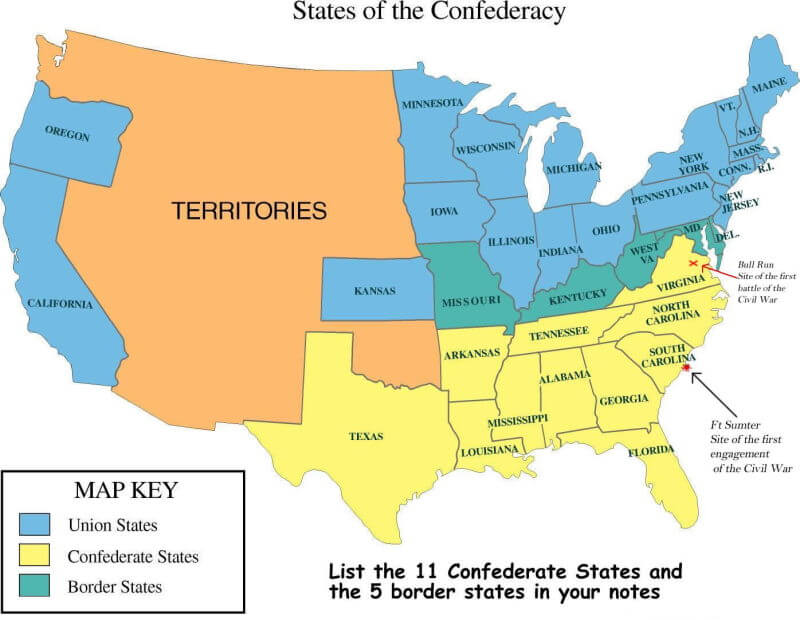
The Civil War ended in Confederate surrender in 1865.
Contents
Causes
In the 1800s when the United States was making tremendous economic growth, some fundamental economic differences existed between the country’s northern and southern regions.
The north was flourished with well established manufacturing and industries, agriculture was mostly limited to small-scale farms, thus limiting the need for slaves. The southern economy depended on large scale farming that depended on the labour of Black enslaved people to grow crops.
Growing abolitionist movements and opposition in the North for slavery after the 1830s led many southerners to fear that the existence of slavery, and thus the backbone of their economy, was in danger.
The abolitionist North and pro-slavery South, both consisted of 11 states each. But in 1819, as America expanded westwards, Missouri, the newest state to jain, joined the south as a slave state, misbalancing the proportion to 12:11. This made both the sides look at each other with suspicion.
Thus, the main reason behind the Civil War was the uncompromising differences between the free and slave states. The election of Abraham Lincoln as the President was the last straw in the opposition from the North.
Outbreak of the Civil War
The first shot of the Civil War was fired by the Confederate army (Southern army) as they successfully took control over Fort Sumter in Charleston, South Carolina (refer to Map1). In response to this, Lincoln called for 75,000 volunteers to join the military, as four other states ceded to join the Confederacy, and the other northern states listened to Lincoln’s call.
On 21 July 1861, the first official battle of the Civil War, the battle of Bull Run (try to find in Map2), was fought when 35,000 Confederate soldiers near Manassas forced the Union (Northern) forces to withdraw and move to Washington D.C., to the disappointment of the Union who hoped for a quick victory.

The Civil War in Virginia
In the spring of 1862, George B. McClellan, the supreme commander of the Union Army, finally led his army up the peninsula between the York and James Rivers, capturing Yorktown on May 4. But the forces of the Southern Army drove back McClellan’s army in the Seven Days’ Battles (June 25-July 1).
The defeat led to the rise of Gen. Robert E. Lee of the Confederate army, who after his win in Manassas, began to move north in Maryland.
In September the first Confederate invasion of the North began under Lee, in Maryland and he met with McClellan who engaged against Lincoln orders, forcing Lee to retreat to a defensive position in Antietam Creek, near Sharpsburg.
Three days later, Lee was attacked by the Army at Antietam leading to the bloodiest single day war of the Civil War. The Confederate suffered 13,724 and the Union suffered 12,410 causalities.
The Emancipation Proclamation and Towards the End
The Proclamation of Emancipation was issued by Lincoln, following the victory at Antietam, freeing the slaves in the eleven seceded states but not the border states (refer to Map1) that were still loyal to the Union. The proclamation ensured the participation of some 1,86,000 black soldiers in the Union army of whom 38,000 died by the time that war ended. For the first time, black soldiers could fight for the U.S. Army.
Maj. Gen. Joseph Hooker, who was defeated by Lee at Chancellorsville, Virginia (refer to Map2), replaced General Ambrose, who was defeated at Fredericksburg (refer to Map2). The Confederate army suffered 13,000 casualties which were somewhere near 22 per cent of their troops while the Union lost 15 per cent during the battle. The Confederate army suffered another loss soon when Lee moved forward to launch another offensive near Gettysburg, southern Pennsylvania against General George Meade on 1 June.
The Union did not launch/failed to launch a counter-attack and Lee and his army was able to escape into Virginia, ending the last Confederate invasion of the North.
Maj. Gen. John Pope, the new commander of the Union army, along with Brig. General Ulysses Sthen, successfully removed another band of the Confederate army from the Mississippi River. The Confederates were defeated in their attempts to capture Kentucky and Chattanooga by the Union army under the leadership of Grant.
In March 1864, Ulysses S. Grant was placed in charge of all the Union armies by Lincoln. He went west to pursue the Confederate army in northern Virginia. Despite suffering heavy casualties in the Battle of the Wilderness and Spotsylvania (both May 1864) and at Cold Harbor (early June), he still managed to secure Petersburg.
On the other hand, Sherman sized Atlanta by September and gathered some 60,000 Union troops in what has been labelled the “March to the Sea” capturing Georgia and Savannah by 21 December. By Mid-February 1865 Sherman has captured Columbia and Charleston South Carolina and North Carolina by mid-April.
On 9 April, Lee surrendered to Grant at Appomattox Court House. John Wilkes Booth, an actor and Confederate sympathiser, assassinated President Lincoln at Ford’s Theatre in Washington on April 14 while another band of the Confederate army surrendered on April 26, bringing the Civil War to an end.
References:
Quiz Time!
- What are some other names for the American Civil War?
- Explain why the South wanted slavery to continue.
- Describe the Proclamation of Emancipation.
- Fill in the blanks:
a. The American Civil War from_________ is the central event in America’s history after decades of tensions between the northern and southern states over _______,________ and _________.
b. Seven southern states or __________ states of America (South Carolina, Mississippi, Florida, Alabama, Georgia, Louisiana and Texas) seceded from the nation to form the Confederate States of America, soon four more states joined them.
c. The first shot of the Civil War was fired by the __________ army as they successfully took control over Fort ________ in Charleston, South Carolina.
d. The Proclamation of Emancipation was issued by ____________, freeing the slaves in the eleven seceded states.
e. Growing _______ movements and opposition in the North for slavery after the 1830s led many southerners to fear that the existence of slavery was in danger.
f. _________________ assassinated President Lincoln at Ford’s theatre in Washington on April 14.
5. ________________ ensured the involvement of black soldiers in the U.S. Army for the first time.
a. Abraham Lincoln
b.The American Revolution
c.the Proclamation of Emancipation
d.the Confederate army
6. On 9 April, ______ surrendered to Grant at Appomattox Court House.
a. the Confederate army
b. Gen. Robert E. Lee
c. Ulysses S. Grant
d. George B. McClellan


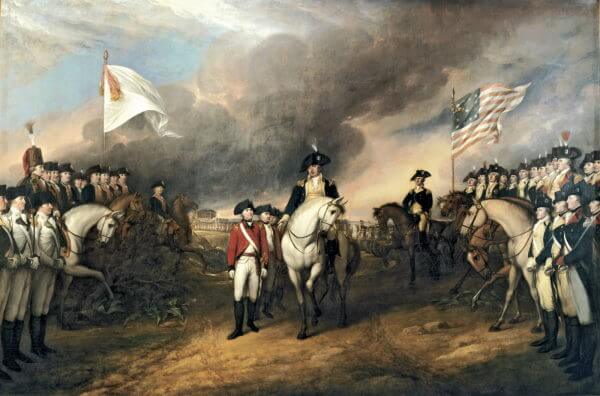
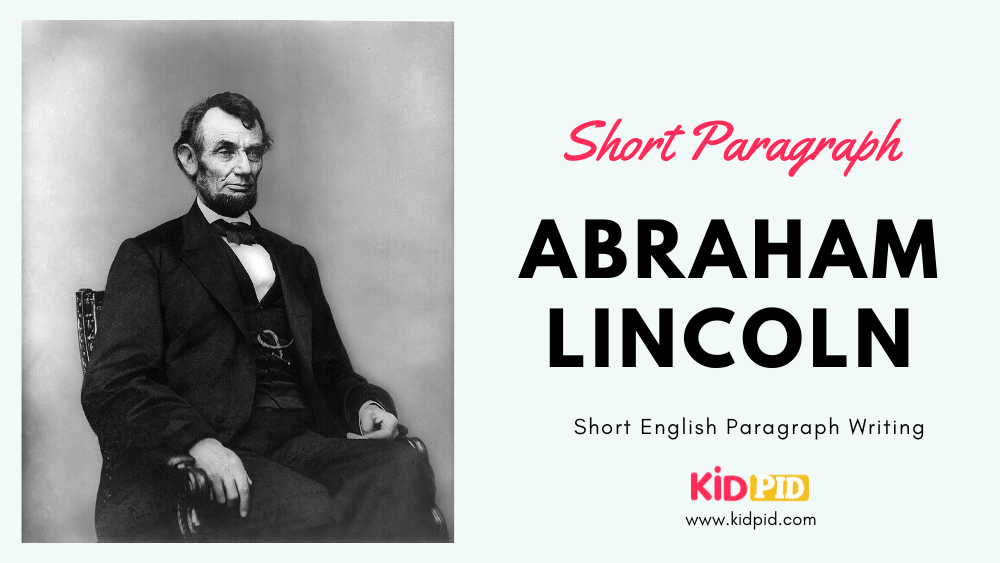

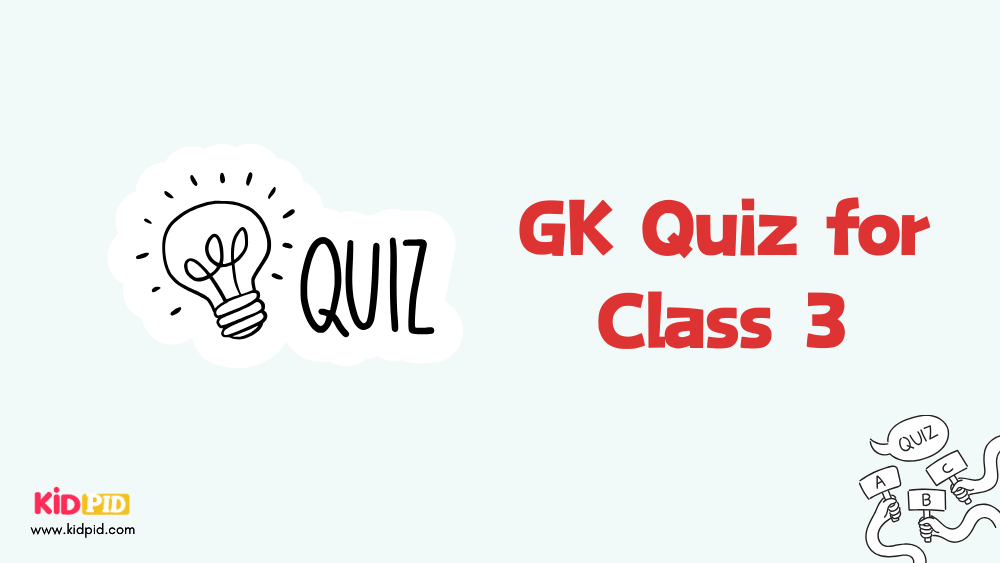
Responses